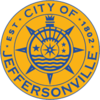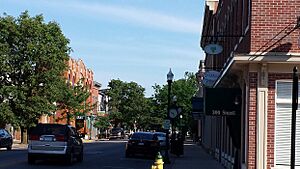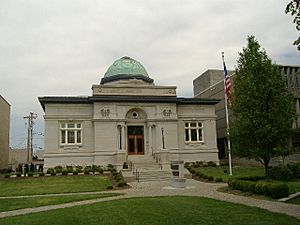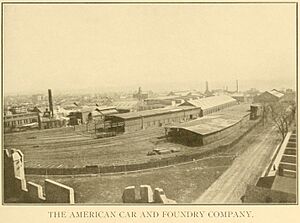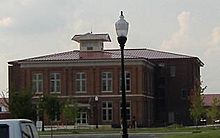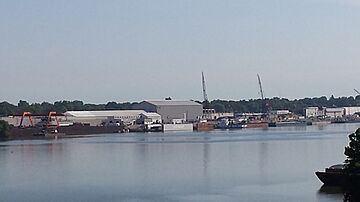Jeffersonville, Indiana facts for kids
Quick facts for kids
Jeffersonville, Indiana
|
|||||
|---|---|---|---|---|---|
| City of Jeffersonville | |||||

Skyline of Jeffersonville
|
|||||
|
|||||
| Nickname(s):
Jeff
|
|||||
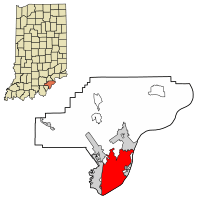
Location of Jeffersonville in Clark County, Indiana
|
|||||
| Country | United States | ||||
| State | Indiana | ||||
| County | Clark | ||||
| Established | 1801 | ||||
| Area | |||||
| • Total | 34.35 sq mi (88.97 km2) | ||||
| • Land | 34.08 sq mi (88.26 km2) | ||||
| • Water | 0.28 sq mi (0.71 km2) | ||||
| Elevation | 538 ft (164 m) | ||||
| Population
(2020)
|
|||||
| • Total | 49,447 | ||||
| • Density | 1,451.04/sq mi (560.26/km2) | ||||
| Time zone | UTC−5 (EST) | ||||
| • Summer (DST) | UTC−4 (EDT) | ||||
| ZIP codes |
47130, 47131, and 47199
|
||||
| Area code(s) | 812 & 930 | ||||
| FIPS code | 18-38358 | ||||
| GNIS feature ID | 2395463 | ||||
Jeffersonville is a city in Indiana, United States, located right along the Ohio River. It is the county seat of Clark County. People often call the city by its shorter name, Jeff. It sits directly across the Ohio River from Louisville, Kentucky. In 2020, about 49,447 people lived here.
The city started as a small settlement near Fort Finney in 1786. It was named after Thomas Jefferson in 1801, the year he became president.
Contents
- History of Jeffersonville
- Jeffersonville's Geography
- Population and People
- Economy and Businesses
- Education in Jeffersonville
- Fun Events in Jeffersonville
- Places to Visit Nearby
- Notable People from Jeffersonville
- See also
History of Jeffersonville
Early Beginnings (1700s)
The area where Jeffersonville now stands began as a military outpost. In 1786, Fort Finney was built near where the Kennedy Bridge is today. The U.S. Army chose this spot because it had a good view of a bend in the Ohio River. This helped protect settlers from Native Americans.
Over time, a small community grew around the fort. In 1791, the fort was renamed Fort Steuben. It was later abandoned in 1793.
Growing as a City (1800s)
How Jeffersonville Got Its Name
It's not exactly clear when the settlement became known as Jeffersonville. It was likely around 1801, the year Thomas Jefferson became president. In 1802, local residents used a special grid plan designed by Thomas Jefferson to form the city. A post office opened in the city on September 13, 1803.
In 1808, Indiana's second federal land sale office opened in Jeffersonville. This helped more people move to Indiana, especially after the War of 1812 ended.
County Seat Changes
In 1802, Jeffersonville became the county seat for Clark County, replacing Springville. Then, Charlestown became the county seat in 1812. But in 1878, Jeffersonville became the county seat again, and it has been ever since.
For a short time in 1813 and 1814, Jeffersonville was almost the capital of the Indiana Territory. The governor, Thomas Posey, preferred living in Jeffersonville to be closer to his doctor. However, the territorial legislature stayed in Corydon.
Shipbuilding Industry
Shipbuilding started in Jeffersonville in 1819. Steamboats quickly became very important to the city's economy. In 1834, James Howard built his first steamboat, the Hyperion, in Jeffersonville. He started his shipbuilding company there.
His business moved to Madison for a few years but returned to the Jeffersonville area in 1849. It settled in Port Fulton. Today, there's an annual festival in September called Steamboat Days. It celebrates Jeffersonville's rich shipbuilding history.
Underground Railroad Role
Indiana was a free state next to the South, making it a key part of the Underground Railroad. By 1830, Jeffersonville was a major path for people escaping slavery from Louisville across the Ohio River. Many people seeking freedom passed through Clark County on their way north to Canada.
Several Jeffersonville citizens helped people escape slavery. In the 1850s, Mayors Oswald Wooley and Uriah Damron were arrested for helping enslaved people flee. In 1863, Hannah Tolliver, a Black wash woman, was arrested in Louisville while helping another woman cross the Ohio River to freedom. She was sent to prison.
Dr. Nathaniel Field, who moved to Jeffersonville in 1829, led Underground Railroad activities in the city. He would hide escapees in his cellar during the day. At night, he would send them to the next safe stop. Field was also the President of the Indiana Antislavery Society.
Civil War Impact
Camp Joe Holt
During the American Civil War, Jeffersonville was a main gateway to the South. This was because it was directly across from Louisville. Three railroads and the Ohio River connected Jeffersonville to the North. The Louisville and Nashville Railroad linked Louisville to the South. These connections made Jeffersonville a good place to store supplies and house troops for the Union Army.
In 1862, the first military camp was set up in the city. It was named Camp Joe Holt. Later, this camp was turned into a hospital, also called Joe Holt Hospital.
Protecting Louisville
In September and October 1862, two Confederate armies moved towards Louisville. Louisville was a very important city for the Union. General William "Bull" Nelson told women and children to leave. So many people fled across the river to Jeffersonville that hotels and rooming houses were completely full.
On September 24, General Don Carlos Buell and his 100,000 Union soldiers reached Louisville just before the Confederates. They successfully defended the city and stopped any invasion.
Jefferson General Hospital
From 1864 to 1866, Port Fulton (which is now part of Jeffersonville) was home to Jefferson General Hospital. This was the third largest hospital in the country at that time. It was built to replace Joe Holt Hospital. The hospital was located near the Ohio River, making it easy to bring patients from riverboats.
The hospital had 24 wards, shaped like spokes on a wheel, all connected by a half-mile-long hallway. Each ward was 150 feet long and could hold 60 patients. During its almost three years of operation, the hospital cared for over 16,000 patients. It also served more than 2.5 million meals.
Quartermaster Depot Construction
The Jeffersonville Quartermaster Depot started during the early days of the Civil War. It was a storage place for the Union Quartermaster Department, which handled military supplies. When the war ended, most military supply depots along the Ohio Valley closed. Only Jeffersonville's remained open.
In 1871, the U.S. Army began to bring all its operations in the city into one four-block area. Throughout the rest of the 1800s, the Quartermaster Depot continued to supply troops. These troops were involved in frontier wars with Native Americans.
Modern Jeffersonville (1900s and 2000s)
Carnegie Library Built
On December 17, 1900, Jeffersonville opened a new public library. It was in a room above the Citizens National Bank and had 1,400 books. Soon, the Carnegie Foundation gave $16,000 to build a new library.
The new building was designed by local architect Arthur Loomis. It had a beautiful Beaux-Arts style with a copper dome. The cornerstone was laid on September 19, 1903, in Warder Park. When the Carnegie Library opened in 1905, it had 3,869 books.
The Ohio River Flood of 1937 caused the library to lose almost all its books. However, it reopened in November 1937 thanks to hard work and donations.
World War I Contributions
During World War I, Jeffersonville helped the war effort by producing many goods. The Quartermaster Depot made items like saddles, harnesses, stoves, and kitchen tools. It became known as "America's largest shirt factory" because it produced 700,000 shirts each month.
The American Car and Foundry Company's local factory also made many products. These included parts for over 228,000 artillery shells. After the war ended in 1918, the number of workers at the Quartermaster Depot decreased.
The Great Flood of 1937
Jeffersonville was one of many communities hit by the Ohio River flood of 1937. After heavy rains in mid-January, 90% of the city was underwater. Electricity was lost, all roads were covered, and a levee broke.
The Indiana National Guard came to help people who had to leave their homes. They gave out emergency supplies, gave shots for typhoid fever, and cleaned drinking water. By the end of the month, the water began to go down. The flood caused about $250 million in damage across the Ohio Valley.
"Little Las Vegas" Era
In the 1930s and 1940s, gambling played a big part in Jeffersonville's recovery. This helped the town bounce back from the Great Depression and the 1937 flood. Because of this, Jeffersonville earned the nickname "Little Las Vegas". Famous people like Clark Gable and Al Capone visited the city.
However, public opinion turned against gambling after a person was killed in 1937. In 1938, James L. Bottorff became judge and said gambling would not be allowed. The Club Greyhound, a dog racing track known for unfair races, was closed within a year. Other gambling places soon followed.
World War II Efforts
The U.S. Navy bought the Howard Shipyards in 1925. During World War II, the Jeffersonville Boat & Machine Company (later called Jeffboat) received a contract to build boats. Jeffboat built landing vessels, like the LST. The number of employees grew from 200 to 13,000 people. After the war, the Navy sold the shipyard to Jeffboat.
Also during World War II, the Quartermaster Depot, along with Fort Knox, Kentucky, held German prisoners of war until 1945.
Ending School Segregation
Jeffersonville ended segregation in its public schools in 1952. This was two years before the Supreme Court ruled that segregation was unconstitutional in the Brown v. Board of Education case. Before this, Jeffersonville High School was only for white students. Black students went to Taylor High School.
While The New York Times praised Jeffersonville for its actions, integration had a downside. Black teachers who worked at Taylor High School lost their jobs when the schools combined.
City Growth and Annexation
On February 5, 2008, Jeffersonville officially added four new areas to the city. This process is called annexation. The city gained about 5,500 acres and 4,500 citizens, bringing the population to an estimated 33,100.
Later, lawsuits against the city were dismissed on February 25, 2008. This allowed the remaining area, Oak Park, to become part of the city. This made Jeffersonville's population grow to nearly 50,000 people. It was the largest annexation in the city's history.
Big Four Pedestrian Bridge and Station
The Big Four Bridge was turned into a pedestrian bridge in 2014. This was a joint project between the governments of Kentucky and Indiana. About 1.5 million people walk or bike across the half-mile bridge each year. The bridge has colorful LED lights that shine from evening until 1 AM.
On the Jeffersonville side of the bridge, the city built Big Four Station. This is a plaza and park with green spaces and fountains. It also has a farmers market on Saturdays, a restroom, a bike-sharing station, a pavilion, and a playground. It offers easy access to downtown shops and restaurants. Big Four Station also hosts the annual Abbey Road on the River, the world's largest Beatles-inspired music festival.
Jeffersonville's Geography
According to the 2010 census, Jeffersonville covers about 34.35 square miles (88.97 square kilometers). Most of this area, about 34.06 square miles (88.26 square kilometers), is land. The remaining 0.29 square miles (0.71 square kilometers) is water.
Population and People
| Historical population | |||
|---|---|---|---|
| Census | Pop. | %± | |
| 1850 | 2,122 | — | |
| 1860 | 4,020 | 89.4% | |
| 1870 | 7,254 | 80.4% | |
| 1880 | 9,357 | 29.0% | |
| 1890 | 10,666 | 14.0% | |
| 1900 | 10,774 | 1.0% | |
| 1910 | 10,412 | −3.4% | |
| 1920 | 10,098 | −3.0% | |
| 1930 | 11,946 | 18.3% | |
| 1940 | 11,493 | −3.8% | |
| 1950 | 14,685 | 27.8% | |
| 1960 | 19,522 | 32.9% | |
| 1970 | 20,008 | 2.5% | |
| 1980 | 21,220 | 6.1% | |
| 1990 | 21,841 | 2.9% | |
| 2000 | 27,362 | 25.3% | |
| 2010 | 44,953 | 64.3% | |
| 2020 | 49,447 | 10.0% | |
| Source: US Census Bureau | |||
2010 Census Information
In 2010, there were 44,953 people living in Jeffersonville. There were 18,580 households and 11,697 families. The city had about 1,320 people per square mile.
Most of the people in the city (80.4%) were White. About 13.2% were African American, and 1.1% were Asian. About 4.1% of the population identified as Hispanic or Latino.
The average age in the city was 37.3 years old. About 23.2% of residents were under 18 years old. About 11.9% were 65 years or older. The population was almost evenly split between males (48.8%) and females (51.2%).
Economy and Businesses
Many businesses, both local and national, are located in Jeffersonville. In 2020, some of the largest employers included: Greater Clark County Schools (1,600 employees), Clark Memorial Hospital (1,500 employees), and Heartland Payment Systems (850 employees).
Local Restaurants
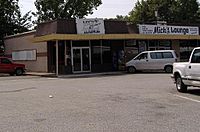
Jeffersonville has many restaurants along the riverfront, downtown, and in other areas like the Quartermaster Depot. These include small bars, restaurants, and fast food places. Jeffersonville is also where the pizza chain Papa John's Pizza first started.
Kitchen Kompact Company
Kitchen Kompact makes cabinets in a part of the old Quartermaster Depot. Their large facility is 750,000 square feet. It employs almost 300 workers. They produce about 10,000 cabinets per work shift.
National Processing Center
Jeffersonville is home to the United States Bureau of the Census's National Processing Center. This is the main place where the bureau collects and processes data. The facility is about one million square feet. It processes millions of forms each year. It employs between 1,200 and over 6,000 people, making it one of the largest employers in southern Indiana.
River Ridge Commerce Center
The River Ridge Commerce Center is a large industrial area. It is located on the edge of Jeffersonville, near Charlestown, Indiana. This area used to be the Indiana Army Ammunition Plant. Now, it hosts many different industries. These include manufacturing, aerospace, automotive, food and beverage companies, and logistics.
Shipbuilding Industry's End
Until 2018, Jeffersonville was home to Jeffboat. This company was the largest inland shipbuilder in the U.S. At its busiest, the company, which made barges, had over 13,000 employees. Jeffboat closed because too many barges were being produced. This marked the end of 200 years of shipbuilding in Jeffersonville. In 2022, city officials announced plans to redevelop the 80-acre property.
Education in Jeffersonville
Public schools in Jeffersonville are part of the Greater Clark County Schools system.
Public Schools
- Franklin Square Elementary
- Thomas Jefferson Elementary
- Northaven Elementary
- Riverside Elementary
- Wilson Elementary
- Parkview Middle School
- River Valley Middle School
- Jeffersonville High School
Private Schools
- Sacred Heart Catholic School
Fun Events in Jeffersonville
- Taste of Jeffersonville
- Abbey Road on the River, a music festival
- The Great Steamboat Race
- Jammin in Jeff, a Riverstage concert series
- Southern Indiana Pride Parade & Festival
- Spring Street Festival, a local art show
- Steamboat Days, a local celebration
- Thunder Over Louisville, an air show and fireworks display
Places to Visit Nearby
- Big Four Bridge
- Clark County Indiana Museum
- Falls of the Ohio National Wildlife Conservation Area
- Howard Steamboat Museum
- Jeffersonville Township Public Library
- Jeffersonville Quartermaster Depot
- NoCo Arts and Cultural District
- Schimpff's Confectionery
- Vintage Fire Museum
- Warder Park
Notable People from Jeffersonville
- Ernie Andres, MLB baseball player and basketball coach
- William Branham, evangelist
- Nick Dinsmore, professional wrestler
- Amanda Ruter Dufour, poet
- Drew Ellis, MLB fielder
- Mike Flynn, basketball player
- Jonas Ingram, United States Navy admiral and Medal of Honor recipient
- Judy Lynn, country music singer
- Travis Meeks, musician
- Zach Payne, member of the Indiana House of Representatives
- Linda Ridgway, artist
- Duane Roland, guitarist, co-founder of Molly Hatchet
- Jermaine Ross, NFL wide receiver
- John Schnatter, entrepreneur, founder of Papa John's Pizza
- Walt Terrell, MLB pitcher
- Jimmy Wacker, MLB pitcher
- Richard B. Wathen, politician
- June Weybright, composer
- Natalie West, actress
See also
 In Spanish: Jeffersonville (Indiana) para niños
In Spanish: Jeffersonville (Indiana) para niños



